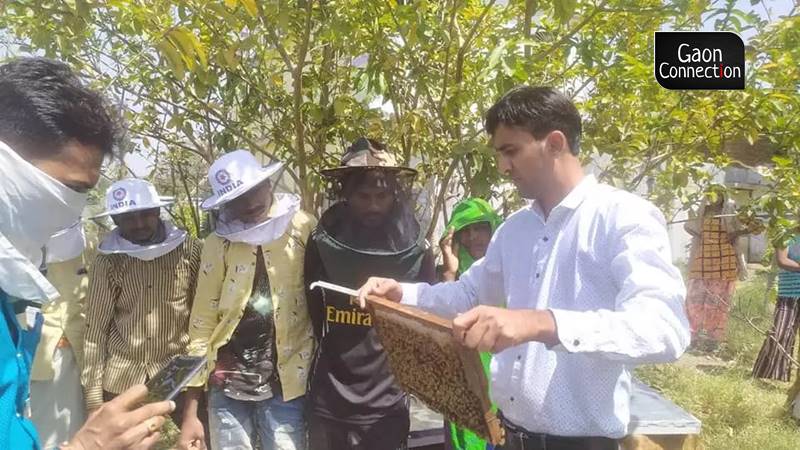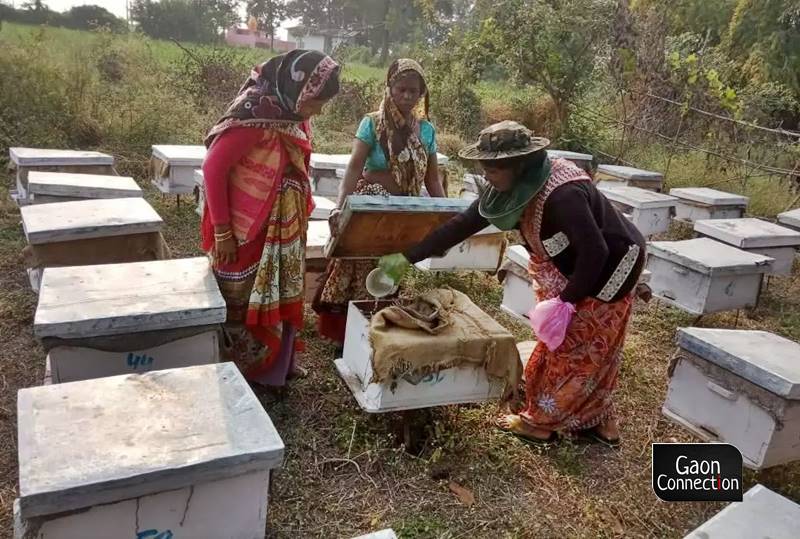Approaching winters are busy times for both bees and the bee-keepers
Pravin Raghuvanshi, an entrepreneur and trainer who trains farmers in bee-keeping in Betul district, Madhya Pradesh, has created a buzz with his 100 bee boxes, which, on an average, get him about 3,000 kilogrammes of honey. Bee-keeping is a lucrative enterprise, he assures.


While there is a demand locally for honey, even internationally there is an interest for Indian honey.
Betul, Madhya Pradesh
The rabi (winter) season is perfect for the business of beekeeping as there is a proliferation of flowering in crops such as mustard, sunflower, coriander, etc., that lends itself to a healthy output of honey.
Pravin Raghuvanshi, who lives in Sanwri village in Betul district of Madhya Pradesh, is a busy farmer these days. An entrepreneur and trainer who has been training other farmers in beekeeping, Raghuvanshi also supplies people with colonies of honey bees and bee boxes.
“Beekeeping can bring in additional income to farmers. A first time beekeeper can start with just five bee boxes,” Raghuvanshi, who lives in Sanwri village in Betul district, Madhya Pradesh, told Gaon Connection.

Raghuvanshi himself has a 100 bee boxes and on an average he gets about 30 kilogrammes (kgs) of honey from each box. “My hundred boxes are currently in Sawai Madhopur in Rajasthan because right now the bajra (pearl millet) crop is flourishing there which is conducive to making good honey,” he explained. “In the rabi season I will bring the boxes to Betul as the mustard is in full bloom,” he said.
Honey mission
The Honey Mission programme, launched by the Khadi and Village Industries Commission (KVIC) in 2017-18 has been promoting bee-keeping activities. The aim is to provide self-sustaining employment opportunities among farmers, Adivasis and unemployed youth in rural India, especially in economically backward and remote areas.

Under the programme, beneficiaries are provided with bee boxes, live bee colonies, tool kits and training. Till date, a total number of 15,445 beneficiaries have been assisted under the programme.
While there is a demand locally for honey, even internationally there is an interest for Indian honey.
Also Read: Apple and litchi production likely to get affected as honey bees are “locked up” inside their boxes

Farmers, young entrepreneurs and many women in India have taken to beekeeping in a big way. It has given them a steady income as along with the honey they also sell the by-products such as beeswax etc., from it.
According to Agricultural and Processed Food Products Exports Development Authority (APEDA), in 2020-21, India exported 59,999.24 metric tonnes of natural honey worldwide that brought in Rs 716.13 crore to the exchequer. There are nearly 500 species of wild flowers in the forests of India from which honeybees make honey, APEDA noted.
Shifting gains
Raghuanshi advises beekeepers to keep shifting their bee boxes. This increases the production of honey, the trainer said. But, the shifting ideally should be done at night, he advised.
“I obtain honey from the bee boxes thrice a year. From each box I get about thirty kilos of honey ” Raghuvanshi said. The honey is bountiful when the bee boxes are nearabout mustard fields. However, Raghuvanshi said a good haul of honey is also obtained from jamun, neem, mango, moringa (drumstick tree), etc. too.

Also Read: How often do you hear the buzzzzz now? Why can’t you find many beehives around?
The success of a honey enterprise in rural India, Raghuvanshi pointed out, depends on factors such as the number of bee boxes utilised, the methods employed in beekeeping, the flora surrounding the area and of course, how well the honey is marketed.
“One can get as much as three thousand kilos of honey out of a hundred bee boxes annually. And the income from this could be as much as ten lakh rupees,” Raghuvanshi pointed out. The investment on the upkeep etc, would be up to four lakh rupees, and the rest would be profits, he added.
“There is ample demand for good quality honey in the market. The important thing is never to compromise with the quality of your honey,” he said.
According to him, the purest honey is the comb honey which can sell for as much as Rs 2,000 a kilo. The other kinds of ordinary honey can go for anything between Rs 500- Rs1,000 a kilo, he informed Gaon Connection.
Also Read: Creating a buzz to tackle an elephantine problem
It is important to keep the honeybees nourished and in good health. In summers when it is hot and there is a paucity of flowers, in order to keep the honey bees alive and nourished, Raghuvanshi keeps a bowl of sugar syrup near the boxes. In the rainy months the bees are fed pollen, which Raghuvanshi said was available online.
Bees for food chain
The honey bees are a vital link in the food chain too. Agricultural experts say that 70 per cent of the crops are pollinated by honey bees. “Pollination by the honeybees lead to healthy grains that are tasty too. And, since the honeybees suck out the nectar from the flowering crops, the incidence of pest infestation also comes down,” Raghuvanshi explained.
Each honeycomb usually has one queen bee that lays eggs. Ten per cent of the rest of the bees are drone bees that mate with the queen bee, while the remaining are worker bees that feed the queen, drones and larvae, collect the pollen and nectar, and make the honey and wax.
Also Read: Creating new homes for the rhinos in the Terai region of India
There are five kinds of honey bees, some of which are indigenous and some that are not:
- Apis cerana indica is an indigenous species which is easy to raise and maintain. One box of this species can produce up to 10 to 15 kgs of honey a year. These bees do not attack humans.
- Apis mellifera is a European species,also easy to work with. Onebox of these bees can yield up to 60 kgs of honey a year, though in India, usually, it yields about 30 kgs. These do not attack humans either.
- Digona Bee has no sting and its yield is low but the honey that is bitter has many medicinal qualities.
- Apis Florea are smaller in size and found usually in the edge of forests or in them. They flit around the trees and do not remain in the same place. These cannot be raised in bee boxes.
- Apis Dorsata are prone to attack humans in swarms and found in jungles. They are larger in size and also not suitable for beekeeping.
Read the story in Hindi

